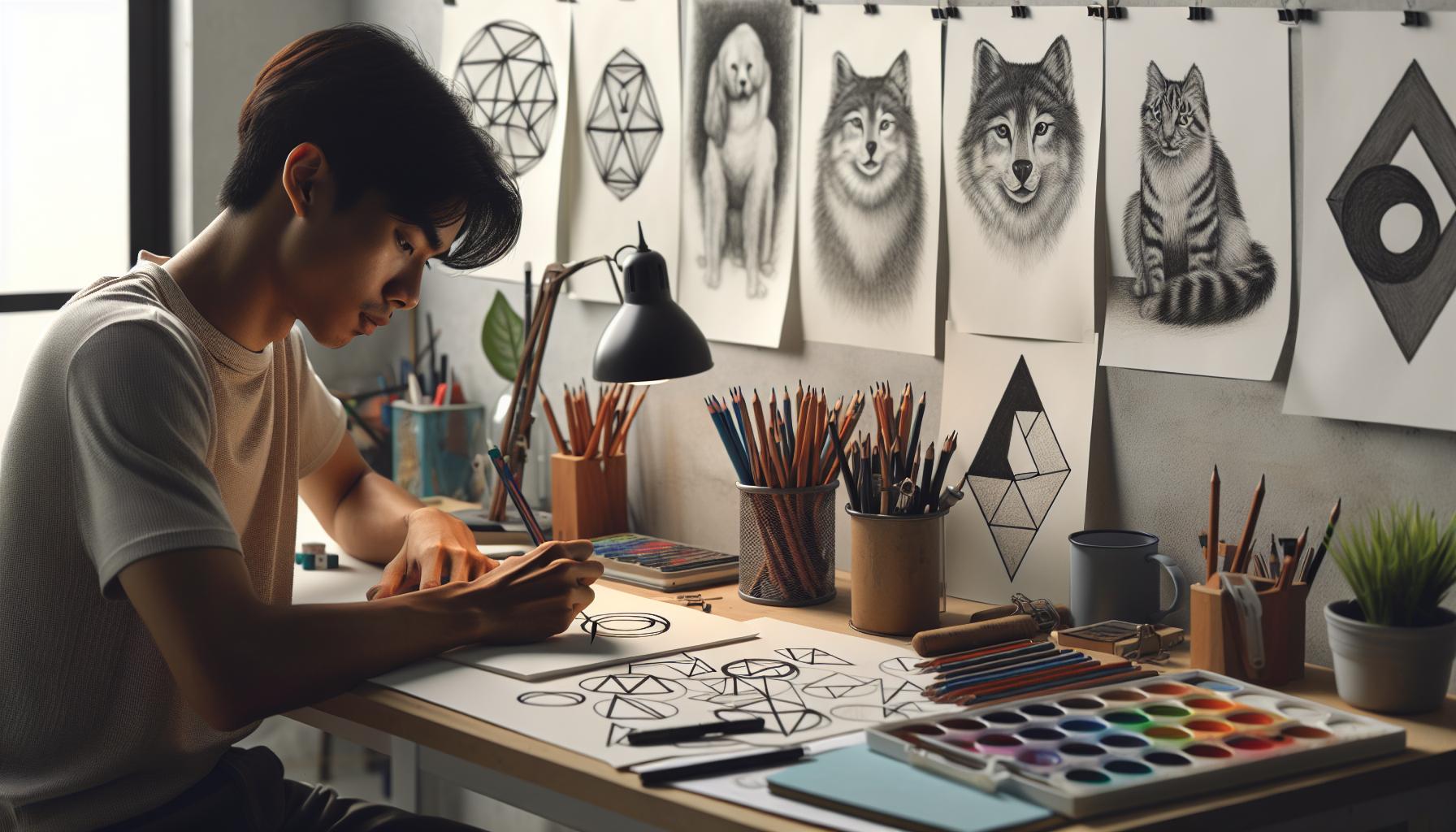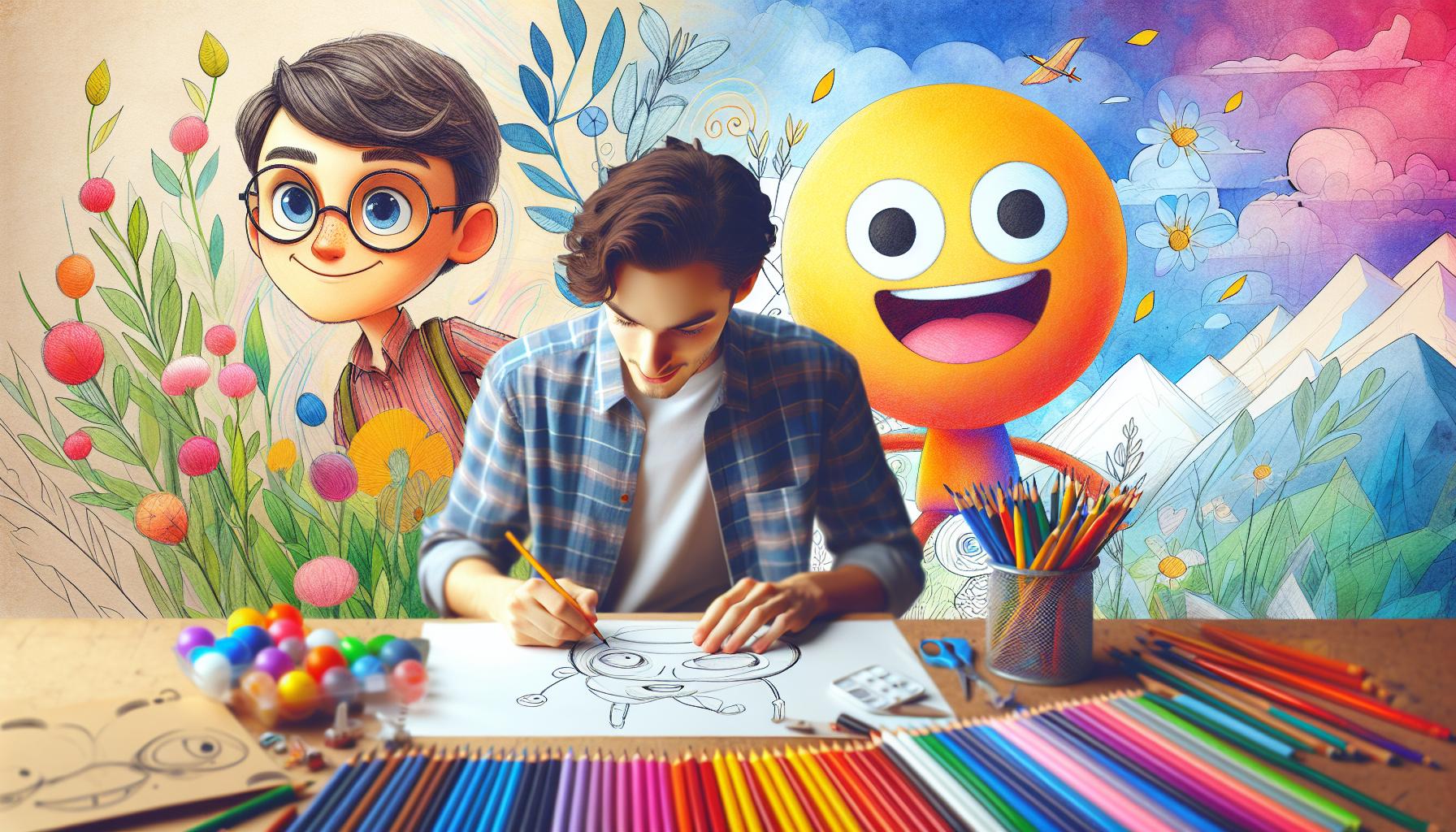Drawing amazing artwork doesn’t have to be complicated. From simple doodles to stunning sketches, anyone can create cool drawings with the right techniques and a bit of practice.
Facil:0fxk9vftpx8= Chidos:ynvg2mk4bce= Dibujos
A “cool” drawing incorporates five essential elements: clean lines, balanced composition, creative subject matter, effective use of space, and attention to detail. Clean lines create smooth, confident strokes that enhance visual appeal. Balanced composition places elements strategically across the canvas to achieve visual harmony.
Creative subject matter transforms ordinary objects into engaging visuals through unique perspectives or unexpected combinations. Examples include:
- Merging two different animals into one creature
- Adding surreal elements to everyday objects
- Incorporating geometric patterns into organic shapes
The effective use of space involves three key techniques:
- Leaving breathing room around focal points
- Creating depth through layering elements
- Balancing positive and negative spaces
| Element | Impact on Drawing |
|---|---|
| Line Quality | 35% of visual appeal |
| Composition | 30% of visual appeal |
| Creativity | 20% of visual appeal |
| Space Usage | 15% of visual appeal |
Simple techniques elevate basic drawings:
- Adding shadows under objects for dimension
- Including texture through repetitive patterns
- Creating contrast with varying line weights
- Implementing basic shading techniques
Dynamic elements enhance visual interest:
- Movement through flowing lines
- Expression through character poses
- Energy through active compositions
- Depth through overlapping shapes
These principles apply to both digital art and traditional mediums, making any drawing style more engaging and visually appealing.
Essential Drawing Tools and Materials


Creating impressive artwork starts with selecting the right tools. The proper combination of materials enhances artistic expression while providing the foundation for developing advanced techniques.
Basic Supplies to Get Started
Traditional drawing essentials include graphite pencils in varying hardness grades (2H, HB, 2B, 6B), high-quality drawing paper, erasers (kneaded, vinyl) for precise corrections, and a pencil sharpener. A set of fine-liner pens (0.1mm to 0.8mm) adds versatility for line work and detailing. Artist-grade sketchbooks provide consistent paper quality for practice and experimentation. Additional tools include:
- Blending stumps for smooth shading transitions
- Drawing boards for a stable work surface
- Measuring tools (ruler, protractor) for precise proportions
- Drawing clips to secure paper
- Pencil grips for extended drawing sessions
Digital Drawing Options
Digital art creation platforms offer extensive creative possibilities through tablets, styluses, and software applications. Professional-grade drawing tablets include the Wacom Intuos Pro, XP-Pen Artist, and iPad Pro with Apple Pencil compatibility. Popular software options include:
- Procreate for iPad users ($9.99 one-time purchase)
- Adobe Photoshop ($20.99/month subscription)
- Clip Studio Paint ($49.99 one-time purchase)
- Krita (free open-source software)
- FireAlpaca (free basic drawing software)
Each platform provides customizable brushes, layers, and digital effects to enhance artwork creation.
Simple Drawing Techniques for Beginners


Mastering basic drawing techniques creates a solid foundation for artistic development. These fundamental methods enable artists to transform simple concepts into visually appealing artwork.
Basic Shapes and Forms
Breaking down complex objects into basic geometric shapes forms the cornerstone of effective drawing. Artists start with circles, squares, triangles or rectangles to establish the core structure of their subjects. A human face breaks down into an oval for the head, circles for eyes, triangles for the nose. Animals translate into combinations of circles and ovals – a cat becomes a large oval for the body, smaller circles for the head, triangles for ears. Architecture reduces to rectangular blocks, while natural elements like trees use triangles for the crown, rectangles for trunks. This geometric approach creates accurate proportions before adding detail.
Shading Methods
Value creation through strategic shading transforms flat drawings into three-dimensional representations. Cross-hatching uses intersecting lines at different angles to build darker values, while circular motions create smooth gradients. Stippling applies dots in varying densities to generate shadows, highlights, textures. The pressure-gradient technique involves adjusting pencil pressure – light touches for highlights, firm pressure for shadows. Blending tools smooth transitions between light and dark areas. Artists combine these methods to achieve depth – cross-hatching for sharp shadows, circular shading for soft transitions, stippling for texture details.
Popular Easy Drawing Ideas


Easy drawing ideas combine simplicity with visual appeal, offering a starting point for artists of all skill levels. These subjects provide opportunities to practice fundamental techniques while creating engaging artwork.
Cartoon Characters
Cartoon characters present ideal subjects for beginner artists due to their simplified forms. Basic shapes form the foundation of popular characters like Mickey Mouse with circular ears or SpongeBob’s square body structure. Artists create expressive faces using simple line combinations: curved lines for smiles dots for eyes or circles for cheeks. Classic cartoon elements include exaggerated features oversized eyes tiny noses or elongated limbs. Popular styles incorporate chibi characters with large heads small bodies or stick figures with distinctive personality traits. Digital artists use layers to build characters starting with rough sketches then adding clean lines colors shading.
Nature Elements
Natural elements offer accessible subjects for drawing practice through basic geometric patterns. Pine trees translate into triangles with horizontal lines while clouds form from connected circular shapes. Flowers emerge from simple patterns: five-petaled designs for daisies spiral centers for sunflowers or heart-shaped petals for roses. Mountains take shape through overlapping triangles rocks appear from angular forms leaves develop from curved lines. Artists create texture using repetitive patterns: parallel lines for wood grain dots for sand or wavy lines for water. These elements combine effectively in landscape drawings allowing artists to build complex scenes from simple components.
Tips to Improve Your Drawing Skills
Regular hand exercises enhance muscle control for smoother lines. Holding the pencil at different angles creates varied line weights for dynamic sketches. Practicing gesture drawing captures movement through quick 30-second sketches of moving subjects.
Drawing from life strengthens observational skills by:
- Sketching everyday objects from multiple angles
- Focusing on light sources to understand shadows
- Recording proportions before adding details
- Using reference points to maintain accuracy
Effective practice methods include:
- Starting each session with warm-up sketches
- Dedicating 15 minutes daily to basic shapes
- Copying master artworks to study techniques
- Maintaining a sketchbook for daily exercises
Advanced skill development requires:
- Studying anatomy to understand form
- Mastering perspective through grid systems
- Developing value ranges in grayscale
- Experimenting with different mediums
Skill progression metrics:
| Time Frame | Focus Area | Expected Progress |
|---|---|---|
| Week 1-2 | Basic shapes | Clean line work |
| Week 3-4 | Shading | Value control |
| Month 2 | Perspective | Spatial awareness |
| Month 3 | Composition | Balance mastery |
- Continuous line drawings without lifting the tool
- Mirror drawing to enhance symmetry skills
- Blind contour drawing for hand-eye coordination
- Timed sketches to increase efficiency
Creating impressive artwork isn’t about innate talent – it’s about dedication practice and the right approach. Artists at any level can develop their skills by focusing on fundamental techniques while exploring their creative expression.
Success in drawing comes from combining basic principles with personal style. Whether working digitally or traditionally choosing the right tools implementing proper techniques and maintaining consistent practice will lead to noticeable improvement.
The journey to becoming a skilled artist is ongoing but highly rewarding. With patience determination and the right guidance anyone can transform simple shapes into captivating artwork that truly stands out.

